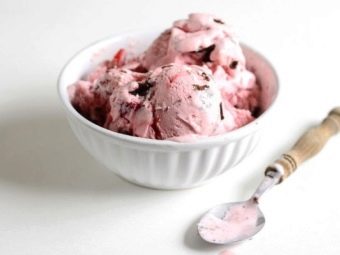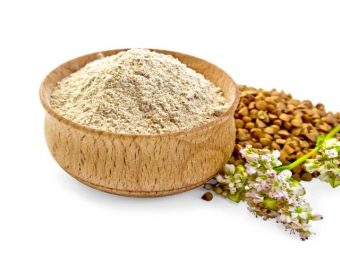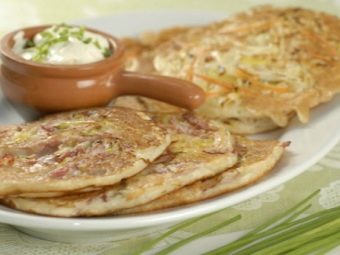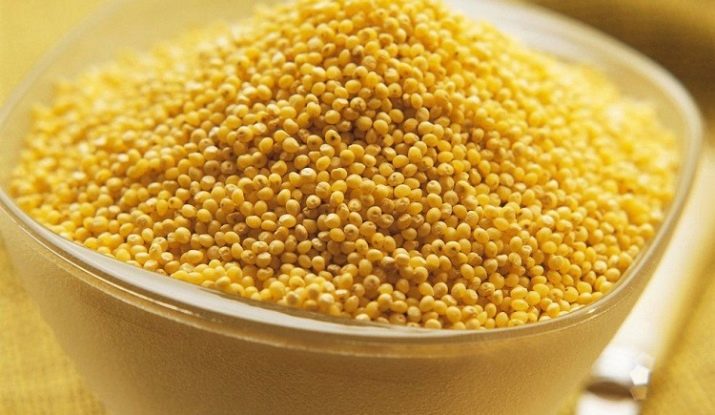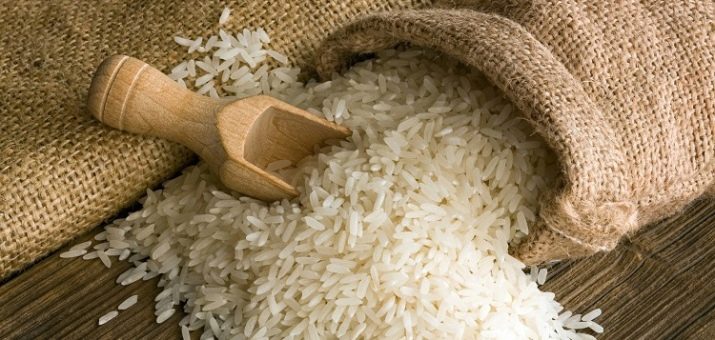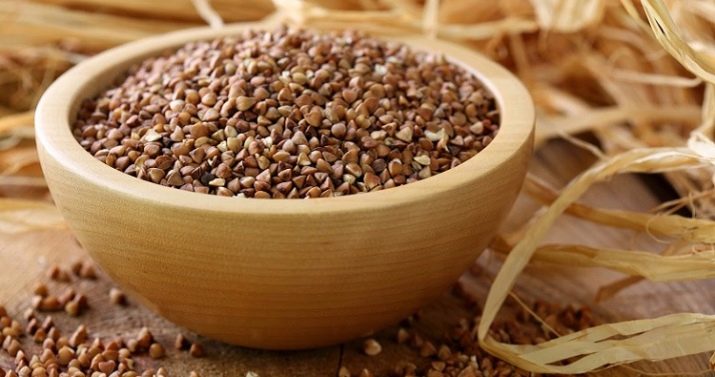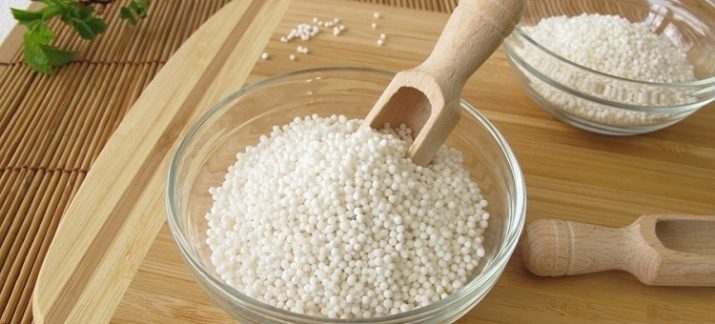Gluten-free cereals: list, basic properties and application
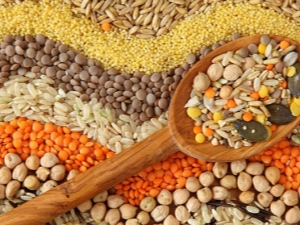
Modern science pays great attention to the correctness of the selection of food.Thanks to recent research, we can consciously abandon what is harmful to our health, and greatly simplify our lives. Recently, a lot has been said that gluten, which is found in many foods, is far from being beneficial for everyone; therefore, special stalls with gluten-free products have even appeared in supermarkets.
Characteristics and basic properties of gluten
Even if you do not really know what gluten is, you probably use it in large quantities and with enviable regularity. This substance, also known as gluten, is a plant protein with a complex structure that is present to some degree in most cereals.
In its pure form, gluten has neither color nor taste, but it is enough to mix it with water so that it shows such properties as grayish color and stickiness, which gave it a name.
Actually, it is thanks to this property of gluten that cereals are made into flour, which makes it possible to knead the dough. From here we draw an obvious conclusion that gluten is present not only in cereals, but also in any flour products. Moreover, the tackiness and tastelessness of this substance forces manufacturers to mix gluten even where it shouldn’t be - it acts as a component that sticks together the rest of the ingredients. In this form, it is quite common in desserts.
People suffering from gluten intolerance, in general, should very carefully read the composition of any products, because gluten may be present even in cosmetics and medicines, but in general, in addition to cereals and bakery products, is also found in dairy products, canned meat and fish, sauces , ice cream and chocolate, sausages and pate.
Even the most unexpected drinks contain gluten - the speech is about juices, coffee with cocoa, and beer with vodka.
You can find gluten in the recipe by finding vague formulations like in the ingredients list. "Textured vegetable protein", "modified food starch" or "hydrolyzed vegetable protein".
Of the cereals, gluten is not rich except rice, buckwheat, millet, and corn grits, as well as cereals, which in fact are not cereals - for example, sorghum or amaranth. Gluten is also not found in meat, fish, fruits and vegetables, and many other products, but it should be remembered that all this applies only to pure products, whereas for a persistent combination of ingredients gluten is added quite often.
The benefits and harms
In the public consciousness of modern people, the opinion that gluten is harmful is replicated, but in fact it is definitely true only for those who cannot tolerate it. For everyone else, gluten is naturally capable of bringing benefits, otherwise, over the millennia of bread consumption, humanity would simply die out. By itself, this substance is useful for humans with the following characteristics.
- Gluten is a complex compound, which immediately includes 18 amino acids from among those that the human body itself is unable to produce. At the same time, their role for health is very important - they are needed, in particular, for good immunity and full saturation of cells with oxygen. You can get them only with food, and gluten is an opportunity to get all eighteen at once.
- Gluten contains vitamins A and E, as well as group B. The first is a well-known antioxidant that prevents aging, strengthens the immune system and improves eyesight, and also prolongs the life of the hair, skin and bones. From the presence of vitamin E depends on how well the chemical processes in the body. Finally, the B vitamins further strengthen the immune system, as well as improve the functioning of the nervous system and are actively involved in metabolism.Of course, all these vitamins are in other products, but you can get them from gluten groats.
- Gluten is rich in calcium and phosphorus, because its use has a very positive effect on the skeleton.
- Gluten also contains, albeit in smaller quantities, iron and carbon, nitrogen and magnesium - all of these elements are the building blocks of which a fully functioning organism is made up.
Now let's talk about why some people should avoid products with gluten, because it is not for nothing that special shelves for such products appeared in the stores. For example, approximately 1% of people on earth have a congenital intolerance of this protein - their body simply perceives such a component as something alien. The problem here lies not even in diarrhea and other characteristic symptoms, which are typical manifestations of intolerance to anything - in the process of the body's struggle with food the intestinal mucosa is damaged, because gluten causes more and more harm with each use.
Although only 1% of the population suffers from complete intolerance, up to one third of all people are hypersensitive to gluten - in particular, after eating foods with its high content, complaints of swelling and heaviness in the stomach are observed. The problem is gluten sticks to the villi and thereby reduces the area of the intestine, which is able to absorb digested food. As a result, it lingers in the gastrointestinal tract longer and can begin to deteriorate, causing food poisoning.
As a person ages, such manifestations become more pronounced, therefore, experts recommend reducing the amount of gluten food over time, although not giving it up completely.
If the food with gluten in the human diet is quite a lot, then the above symptoms may occur even if there is no hypersensitivity. In this case, you can simply temporarily change the menu so that everything goes by itself, but at first the symptoms will still show themselves. When gluten is plentiful, it can even clog the intestines, making food more difficult and even more aggravating the situation.
Finally, recent studies indicate that gluten can be addictiveand then it will be more difficult to refuse the regular use of products based on it. Some scientists also suspect that gluten is one of the main causes of acne. The latter effect has not been studied to a proper extent and has not even been properly proven, however, many nutritionists are already advising people with skin problems to try to reconsider their diet.
Methods for producing gluten-free products
The most logical way out of the situation would be to use only those products that do not contain gluten a priori, however, as we see, it is almost everywhere today, and for some products it seems almost irreplaceable. In fact, the last statement is fundamentally wrong - today you can replace the ingredient with any properties.
The trick is to replace the gluten-containing ingredient with something else. The difficulty lies in the absence of ideal substitutes - they either fall short of stickiness, or have a more pronounced taste or smell that needs to be masked by adding new ingredients that also begin to influence the appearance of the final product. For this reason, in some cases, manufacturers have to pretty much break their brains before the ready-made recipe is made, and sometimes there may be so much extra, and gluten does not seem so scary.
Oddly enough, the easiest way to make a gluten-free product from baking and pasta, in which there should be a lot of gluten. We have already mentioned above that in some varieties of cereals it is still absent, which means that bakery products either do not contain wheat flour in general, or its percentage is very low.In order to achieve optimal results, manufacturers mix together the flour of different cereals. In some cases, such a reworked copy is almost as good as the original.
With the same canned food and other products that the gluten should not contain in the original, there is a somewhat strange situation - here it is even more difficult to replace gluten, because it was added here specifically to achieve viscosity in the absence of foreign taste and smell. Not having the ability to use a proven and safe ingredient for most people, manufacturers begin to experiment with various food additives, which is not always good, but if a person cannot use gluten in principle, you have to choose with an eye to the diagnosis.
However, even he is not yet a reason to eat anything, because the composition of gluten-free products should definitely be studied more carefully, and absolutely all of these components should be familiar to the conscious consumer and be considered safe.
Croup List
If in other products one can hope for the absence of gluten, then, in the understanding of most people, cereals and products from them are considered to contain gluten. True, nutritionists are not so categorical - both porridges and pastries can be eaten even by people with gluten intolerance; you just need to clearly know what and how much you eat.
Millet
Millet, also known as millet, does not contain gluten in its purest form, so it is completely safe for people with intolerance to this substance. Plus, this porridge is also in the fact that it costs little while being useful - it does not contain gluten, but there is lecithin and fiber, beta-carotene and iron, as well as B vitamins. Another thing is that This product is not suitable for infants under one year old.
Pic
Another cereal, completely devoid of gluten, but much more delicious and involving a wider range of dishes that can be prepared from it. Rice is certainly useful, and the comparatively rare varieties of brown or black grain, which are not cleared of the outer shell, which contain much valuable, are of particular use. Such porridge contains iodine, iron and copper, as well as some amino acids (primarily lysine and methionine) and folic acid.
Rice cereal is also available for prikorma at a fairly early age, but it is better to give preference to ordinary white grain - the child is easier to digest.
Buckwheat
Another very popular gluten-free cereal in our country is buckwheat familiar to everyone. It is appreciated not only for its excellent taste and lightness, but also for its significant content of vegetable protein and vitamin E. It also contains trace elements such as magnesium, iron and potassium. This porridge is generally considered very beneficial for the stomach, since it normalizes the processes of digestion and contributes to the speedy recovery of the intestinal walls from any damage.
It is often advised to begin feeding the babies with buckwheat, which was significantly influenced by the complete absence of gluten in it.
Corn
This cereal for supporters of a gluten-free diet is attractive even not as a porridge, but as a good alternative to wheat flour - at least, from such raw materials you can make fairly believable pasta and breading for various dishes. Such a substitute is relatively inexpensive and widely available, but there are fewer benefits in it - there are many carbohydrates, and quite a few valuable components. However, it can be an excellent source of the same complex carbohydrates, as well as selenium, vitamin A and fiber.
Corn grits are very similar to semolina in their properties, however, unlike the latter, it does not contain gluten at all.
Oats
In terms of gluten content, oatmeal causes rather heated scientific spores - on the one hand, the proteins contained in it supposedly should not cause a characteristic immune response.On the other hand, studies show that co-cultivation along with gluten-containing cereals can affect the grain structure, which makes it unsafe for people who are contraindicated for even a small use of gluten. In short, oats can not be called contraindicated, but it is not worth using any product, but only the one on which it is written that there is no gluten.
On the basis of oats, flakes popular in the people are produced, but from a nutritional point of view, ordinary cereals are much more useful - here both proteins with complex carbohydrates, and vitamins E and groups B, and antioxidants with fiber. Enough here and minerals - phosphorus, iron, magnesium and zinc. Oats protects the intestinal mucosa, allows time to remove excess cholesterol from the body and prevent the occurrence of tumors, so that despite a certain risk and not everyone's favorite taste, it is still worth it. It is important to note that oats do not have to be porridge - in small quantities it can be added to the stuffing for the subsequent preparation of various dishes.
Quinoa
Another gluten-free product that is necessarily included in all the world rankings of useful cereals, but has not yet taken root in our country - here we have hardly heard of it. In appearance, such a grain looks like a mixture of buckwheat with corn, but the taste is more like brown rice. There is a lot of useful in this porridge, but first you need to find it on sale.
Amaranth
This croup also resembles quinoa, but is still a little more common. Appreciate it for the huge content of fiber, contributing to the improvement of the bowel, as well as a positive effect on many other systems of the body. The product is very rich in minerals - iron and zinc, manganese and iodine, as well as selenium and calcium. You should not take this cereal strictly as a porridge - pancakes, baked goods, and even salads are made from it.
Sorghum
This cereal, which does not contain gluten, is one of the most diverse - from it you can make porridge or flour for baking, and you can also make beer on its basis. In the modern world, sorghum is not as highly valued as it used to be, but we note the high content of proteins and starch in its composition.
Sago
And this is not at all a cereal, but a starch of a granular form, which was originally mined from a special sago palm tree. Palm trees are tight, but the similar name is tied to granular potato starch. In any case, there is only one use for such a product - cooking in the form of porridge, and there are practically no proteins, including harmful ones.
Chumiza
This product is sometimes called black rice, although there is another name - Italian millet. We have such a cereal (and products from it - cereal or flour) is difficult to find, but if it exists, you should buy it, because it is a storehouse of B vitamins and carotene, silicon and magnesium, phosphorus and potassium.
Features of use
To eliminate possible consequences, one should not just choose products marked as gluten-free, but also use them according to the correct scheme, following certain rules.
For kids
In the case of small gourmets, it should be remembered that gluten is quite difficult to digest, therefore it is far from a fact that even a healthy body will be able to overcome it without consequences that indicate alleged intolerance. Experts point out that up to about 6-7 months in the child's body there are no enzymes necessary for the breakdown of this protein, and therefore the supplements are advised to start with those cereals in which such a substance is not found.
You should start with buckwheat, as an option - rice or corn, but you should not experiment with artificially gluten-free cereals.
Since gluten is still valuable for the body, over time you need to enter any porridge in the supplements, but because of the potential risk of acute indigestion, you should do this in small portions, carefully monitoring the condition of the child. In any case, it is better not to hurry.
For women
Representatives of the fair sex are most often interested in such moments either during pregnancy and lactation, or in the context of strict adherence to a healthy lifestyle. In the first case, we note that gluten is not contraindicated for pregnant and lactating mothers - if everything is okay with health, then this protein is simply broken down in the body without any consequences for babies. If the only reason for the potential failure is to follow the fashion of your health, then you should not forget about the potential benefits of this substance.
Ladies should take into account the comprehensive utility of gluten, which, by improving the performance of all body systems, makes a woman more attractive. However, we should not forget that over the years, the body can begin to react more acutely to the presence of gluten, because over time its share should be reduced.
For men
Representatives of the stronger sex quite rarely think about the correctness of their diet - until such time as a firm and clear diagnosis is made. If so, the products for your own menu will have to be chosen carefully, but with the right approach you can not deny yourself most gastronomic pleasures.
For example, bread, so necessary for recuperation, may be gluten-free - for such a product, it is usually not just wheat flour that is used, but a mixture of flour from several other cereals. The taste of such a product may vary significantly, but in terms of benefits to the body, the effect is about the same.
Another important moment for many men is alcoholic beverages. It should be noted that gluten is contained in any alcohol produced on the basis of cereals with gluten present in them, which means that such popular in our country beer and vodka, as well as more elite gin and whiskey from the menu should be excluded, since this product segment rarely specially produced in the gluten-free version. Consequently, a strong drink lover will have to switch to liquids such as wine, rum or tequila.
Physician advice
Finally - a few recommendations from nutritionists, which will allow you to stay healthy longer.
- Gluten can not be considered a fundamentally harmful substance - such a reputation it has created a marketers, emit separate counters to goods without fiber. In fact, there is also quite a lot of benefit from this substance, because the number of products with it can be reduced, but you should not refuse them completely, if only it is not a strict diagnosis.
- If gluten is contraindicated to you, be ready to always and everywhere read the composition of everything you buy. Today’s realities are such that this component is found literally everywhere, and it’s much easier to list positions where it doesn’t exist than those where it is. As part of nothing should remain a mystery to the consumer, so if you see incomprehensible wording and notation - do not be lazy to ask the question.
- In pursuit of products that do not contain gluten, do not forget that much of the forbidden food would bring a lot of benefits if it were not for gluten. Denying yourself any food, remember that you are in a losing position and are now forced to pick up the ingredients more actively in order to restore good nutrition with getting all the substances necessary for the body.
About what is gluten and whether it is possible to eat it, see in the next video.



